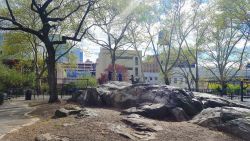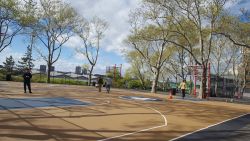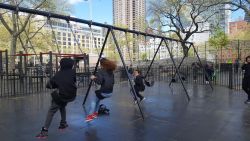De Witt Clinton Park
Remembering Those Who Paid The Ultimate Sacrifice: NYC Parks and Flemish Government Honor Local War Heroes at Historic Clinton War Memorial in De Witt Clinton Park
For Immediate ReleaseFriday, May 24, 2013
No. 49
http://www.nyc.gov/parks
NYC Parks Borough Commissioner William Castro and Kris Dierckx, Representative of the Government of Flanders to the U.S., joined Belgian Consul General Marc Calcoen, German Consul General Busso von Albenslaben, Amy and Emily Schwarz, granddaughters of sculptor Burt Johnson, Mayor’s Office of Veterans Affairs Commissioner Terrance Holliday, and Flanders House New York to honor local war heroes at the historic Clinton War Memorial in De Witt Clinton Park in honor of Memorial Day.
The event included a reading of John McCrae’s famous poem, In Flanders Field, that inspired sculptor Burt Johnson, followed by a playing of taps. Mayor Bloomberg’s proclamation for the occasion was also read.
Located at the southeast corner of De Witt Clinton Park, the poignant monument is the work of sculptor Burt W. Johnson (1890-1927) and architect Harvey Wiley Corbett. It was commissioned by the Clinton District Association as a memorial to the young men from the neighborhood who died in World War I, and was dedicated on June 8, 1930. The monument features a pensive infantryman known as a “doughboy” holding poppies in his right hand and a rifle slung over his left shoulder. The granite pedestal is inscribed with a verse from the famous poem written by John McCrae (1872-1918), In Flanders Fields.
The arrival of the American Expeditionary Force in June 1917 in Europe tipped the balance in favor of the Allied Forces towards the middle of 1918. The four American divisions, 40,000 men in all, who fought in Flanders, arrived in Europe in June of 1918. The 27th and 30th Divisions were engaged in battle on the front south of Ypres. The 37th and 91st Divisions led an attack near the Flemish towns of Waregem and Kruishoutem. The Americans suffered heavy losses, particularly in the Spitaalsbossen, not far from the present day Flanders Fields American Cemetery and Memorial in Waregem, which commemorates the 368 dead and 43 missing soldiers on Belgian territory during World War I.
Today’s event is one of a series organized by the Government of Flanders, Belgium, through Flanders House New York, its U.S. representation, to commemorate the Centennial of World War I (2014-2018). The Flemish Government of Belgium seeks to incorporate the centennial anniversary into a broader framework of “war and peace, remembrance and realization, and international cooperation”. Mr. Kris Peeters, Minister President of the Government of Flanders, stated that “it is our explicit ambition to establish a humanitarian and internationally oriented project, which we wish to associate with the peace theme.” The Flemish government is currently working to sponsor care for a period of six years of the Clinton War Memorial and its surrounding landscape.
Poet McCrae was a Canadian physician and lieutenant colonel who was inspired to write the poem in response to his friend and fellow soldier, Alexis Helmer, who died in the Second Battle of Ypres—a series of military engagements in which many thousands of soldiers died in 1915 in western Belgium. The lines of the poem have resonated for generations, and its image of poppies has become a symbol of loss and remembrance. Burt Johnson selected the motif for the floral tribute carried by his doughboy and the inscription.
The term doughboy was widely popularized in the United States during World War I (1914-1918) to refer to infantrymen. After the war numerous communities commissioned doughboy statues to honor local war heroes. The Clinton War Memorial’s doughboy is one of nine such statues erected in New York City’s parks.
In an unpublished speech delivered by Burt Johnson at Pomona College in 1924 he commented on the important neighborhood and societal role of statues such as this: “Civic sculpture, its subject, its placement and its execution make it a part of the life of the community.” It is a tribute to Johnson’s artistry that though the City and neighborhood may have evolved, his doughboy’s emotive power has endured for future generations.
About Flanders House
Flanders House is an organization in charge of, and representing, the competences of the Government of the region of Flanders, Belgium in the U.S. These include culture, research, education, innovation but also investment and trade, and tourism, among others. For more information on Flanders House New York visit http://www.flandershouse.org/in-flanders-fields.
About NYC Parks Permanent Arts and Monuments
The sculpture collection in New York City's Parks constitutes the greatest outdoor public art museum in the United States. A veritable “Who's who” of American art, it includes the work of nineteenth-century masters such as Augustus Saint-Gaudens, Daniel Chester French and John Quincy Adams Ward, as well as contemporary subjects and conceptions by the likes of Louise Nevelson, George Segal, Alice Aycock and Robert Graham. More than 1,000 monuments, 300 of which are sculptures, grace our most prominent civic spaces as well as the many localities which constitute the greater metropolis. Ranging in size from commemorative tablets to triumphal arches, they honor people and events that helped shape our city, nation, and the international community. It is this cultural and aesthetic legacy that we wish to preserve. For more information on Parks’ art collection visit www.nyc.gov/parks/art.
Check out your park's Vital Signs
Clean & Safe
Green & Resilient
Empowered & Engaged Users
Share your feedback or learn more about how this park is part of a
Vital Park System










